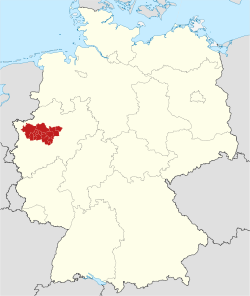Ruhr Region
|
Ruhr Metropolis Metropole Ruhr |
|||
|---|---|---|---|
|
|||
 map of the Ruhr metropolitan region within Germany |
|||
| Coordinates: 51°30′N 7°30′E / 51.500°N 7.500°ECoordinates: 51°30′N 7°30′E / 51.500°N 7.500°E | |||
| Country |
|
||
| State |
|
||
| Largest Cities | |||
| Government | |||
| • Body | Regionalverband Ruhr | ||
| Area | |||
| • Metro | 4,435 km2 (1,712 sq mi) | ||
| Highest elevation | 441 m (1,447 ft) | ||
| Lowest elevation | 13 m (43 ft) | ||
| Population | |||
| • Metro | 8,572,745 | ||
| • Metro density | 1,646/km2 (4,260/sq mi) | ||
| Time zone | CET (UTC+1) | ||
| GRP | 2007 | ||
| Nominal | €136($186) billion | ||
| Website | www |
||
| WWII Ruhr Bombing Operations | |
|---|---|
| 1943 March: | Battle of the Ruhr |
| 1943 May: | Operation Chastise |
| 1944 October: | Operation Hurricane |
| 1944 September: | Bombing of German oil facilities during World War II |
The Ruhr (German pronunciation: [ˈʁuːɐ̯], German: Ruhrgebiet), or the Ruhr district, Ruhr region, Ruhr area or Ruhr valley, is a polycentric urban area in North Rhine-Westphalia, Germany. With a population density of 2,800/km² and a population of eight and a half million, it is the largest urban agglomeration in Germany, and third-largest in the European Union. It consists of several large, industrial cities bordered by the rivers Ruhr to the south, Rhine to the west, and Lippe to the north. In the southwest it borders the Bergisches Land. It is considered part of the larger Rhine-Ruhr metropolitan region of more than 12 million people, which is among the largest in Europe.
From west to east, the region includes the cities of Duisburg, Oberhausen, Bottrop, Mülheim an der Ruhr, Essen, Gelsenkirchen, Bochum, Herne, Hagen, Dortmund, and Hamm, as well as parts of the more "rural" districts of Wesel, Recklinghausen, Unna and Ennepe-Ruhr-Kreis. The most populous cities are Dortmund (approx. 572,000), Essen (approx. 566,000) and Duisburg (approx. 486,000). The Ruhr area has no administrative center; each city in the area has its own administration, although there exists the supracommunal "Regionalverband Ruhr" institution in Essen. Historically, the western Ruhr towns, such as Duisburg and Essen, belonged to the historic region of the Rhineland, whereas the eastern part of the Ruhr, including Gelsenkirchen, Bochum, Dortmund and Hamm, were part of the region of Westphalia. Since the 19th century, these districts have grown together into a large complex with a vast industrial landscape, inhabited by some 7.3 million people (including Düsseldorf and Wuppertal).
...
Wikipedia


